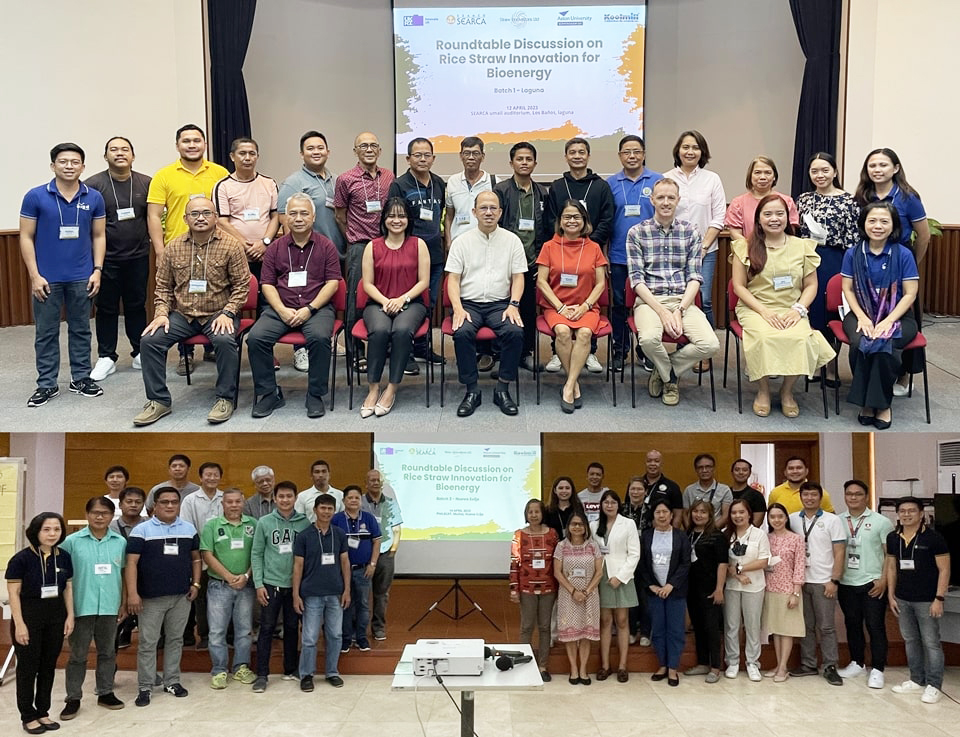Rice farmers and agricultural officers in Laguna and Nueva Ecija have explored the use of rice straw for bioenergy as an alternative to burning waste straw in fields during roundtable discussions convened by the Southeast Asian Regional Center for Graduate Study and Research in Agriculture (SEARCA).
Held in mid-April 2023, the roundtable discussions (RTDs) identified challenges, opportunities, and innovations in implementing local and national policies on rice straw management.
The participants included representatives of local government units, farmer associations, environmental groups, research organizations, and other rice commodity stakeholders from 10 rice-producing municipalities in Laguna and Nueva Ecija.
The RTDs were conducted under the Rice Straw Biogas Hub project jointly implemented by United Kingdom (UK) startup Straw Innovations Ltd., Koolmill, Aston University, and SEARCA with funding from Innovate UK.
The project, which started in September 2022, aims to generate clean energy from waste rice straw and provide innovative technology services for rice farmers.
Rice straw can be collected and processed in a controlled environment to release methane, which can then be captured and used as a clean-burning cooking fuel called biogas. Dr. Victor Luis, project consultant, discussed the benefits of biogas as an energy source and the opportunities to power rice production among other agricultural activities.
Straw Innovations founder and CEO Craig Jamieson presented his company’s central role in the Rice Straw Biogas Hub project, which invested in green technologies to use a highly neglected resource that is rice straw.
He said the partners in the project are implementing four work packages. Straw Innovations handles rice harvesting and bioenergy use for rice drying, while UK enterprise Koolmill takes charge of energy efficient milling. Meanwhile, Aston University conducts the socioeconomic analysis and SEARCA is responsible for the greenhouse gas analysis and enabling environment.
“The RTD is designed to be a mutual learning experience of gaining insights from the attendees while sharing project innovations such as rice straw use for biogas generation,” SEARCA Director Dr. Glenn Gregorio said.
He also stressed that attaining agricultural transformation through innovation takes an open mind and a brave change in policies, processes, and implementation.
The RTDs focused on the negative effects of burning rice straw, including air pollution, greenhouse gas emissions, health hazards, and accidents. The merits of using rice straw for bioenergy, fertilizer, mulching, livestock feed or mushroom substrate were emphasized. SEARCA also introduced the Analytical Hierarchy Process as a decision-making tool to develop a viable business model.
Gregorio said the participants talked about the current state of rice straw uses and disposal, the reasons for burning rice straw, and local policies on rice straw management. They were able to evaluate service options offered by Straw Innovations for rice straw management. They also expressed their training needs and feedback, including a demand for a demonstration of the harvesting technology by Straw Innovations.
He added that the RTDs showed limited awareness and practice among the participants on alternative ways of disposal or use of rice straw as well as a demand for capacity building on straw management strategies and implementation of local policies.
“These findings will serve as a basis for crafting recommendations on the enabling environment of managing rice straw and its use for clean energy,” Gregorio said. — (PR)

